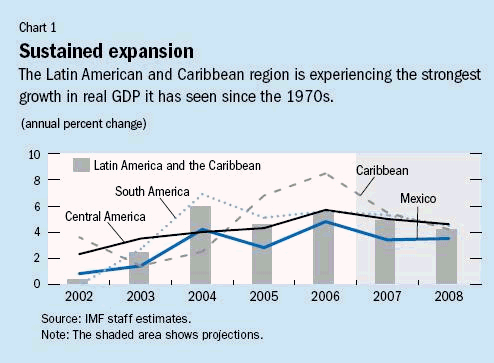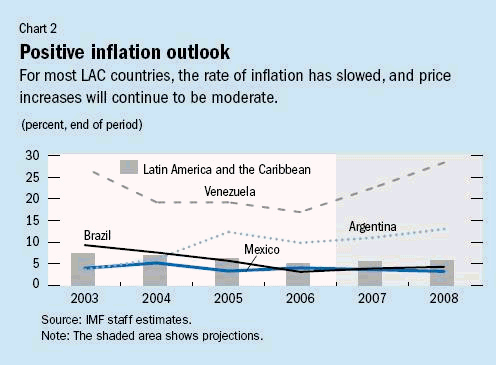
Typical street scene in Santa Ana, El Salvador. (Photo: iStock)
IMF Survey: Latin America Sees Continued Growth
April 23, 2007
- Good performance results from sound policies, benign international situation
- Inflation declined in most of region's countries last year to average of 5 percent
- Inequality remains very high compared with other regions
Latin America is in the middle of its strongest expansion since the 1970s and the outlook remains favorable for sustained growth.

Worker on car assembly line in Argentina, where unemployment fell sharply last year (photo: Tim Brakemeier/DPA)
WESTERN HEMISPHERE OUTLOOK
For most countries the outlook for inflation is good too, according to the IMF's Regional Economic Outlook for the Western Hemisphere.
The good performance has resulted from a combination of generally good economic policies and a benign international economic situation, including high commodity prices that have enabled many countries to raise spending and still reduce deficits, the report said.
As a result of the strong growth, unemployment rates and poverty rates fell and, for the first time in decades there was a moderate reduction in regional income inequality, although it remains quite high compared with much of the rest of the world, according the outlook, prepared twice a year by the IMF's Western Hemisphere Department.
Overall, economic growth was 5.5 percent in the Latin American and Caribbean (LAC) region last year and has averaged 5.25 percent for the last three years. Growth is expected to slow a bit this year, to just under 5 percent, and to about 4.25 percent next year, a reflection of "a deceleration from historically high rates in a number of countries, the slowdown in the U.S. economy, and some declines in commodity prices." (see Chart 1) As the recovery has matured in the region, growth has also become more reliant on domestic demand, which has resulted in a increase in imports in many countries.

Inflation declined in most countries last year, to a regional average of 5 percent, and is expected to rise only slightly in 2007. But the IMF noted that the "decline was not universal." In several countries "inflation accelerated or remained high as economic activity continued to expand beyond potential." (see Chart 2)

The strong growth coupled with moderate inflation and expanded social assistance programs in many countries contributed to a continuing improvement in social indicators. Unemployment rates fell as did poverty rates. The average Latin American poverty rate fell from 44 percent in 2002 to about 40 percent in 2005 and "is estimated to have fallen further to 38 percent in 2006," the report said, citing data from the United Nations Economic Commission for Latin America and the Caribbean. The largest reductions occurred in Venezuela and Argentina. "Falling poverty reflects both strong income growth and a moderate reduction in income inequality," the regional outlook said. It said 13 of the 18 countries for which data are available showed an improvement in income distribution, although inequality "remains very high compared with other regions."
Anoop Singh, director of the Western Hemisphere Department, told reporters that Latin American economic policies "will need to be vigilant to ensure that the safety margins built up during 2006 do not erode over the next year. With public outlays and imports projected to continue growing at high rates, fiscal and external surpluses are expected to decline." That points to the "need to rein in the growth of government spending, especially for current outlays, which have been rising particularly rapidly in recent years."
Singh also emphasized the need to continue to increase equity in Latin America and said living standards can best be raised by continued growth, which although high by Latin American standards, it is no more than "average" when compared with other developing regions.


